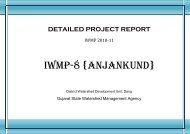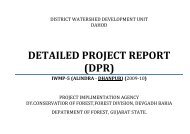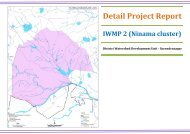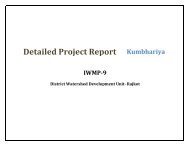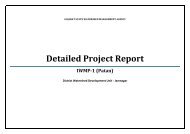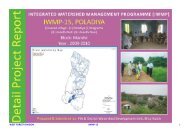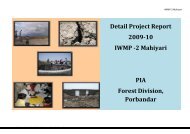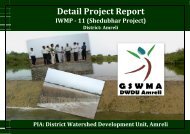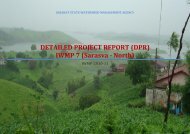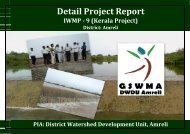IWMP-11 - Commissionerate of Rural Development Gujarat State ...
IWMP-11 - Commissionerate of Rural Development Gujarat State ...
IWMP-11 - Commissionerate of Rural Development Gujarat State ...
You also want an ePaper? Increase the reach of your titles
YUMPU automatically turns print PDFs into web optimized ePapers that Google loves.
DWDU, Rajkot<br />
Agriculural Improvement programme<br />
Our understanding is that without addressing the crucial area <strong>of</strong> end-use regulation, no amount <strong>of</strong> rainwater harvesting is going to<br />
work. For this the most important requirement is the working out <strong>of</strong> a sustainable package <strong>of</strong> practices for dryland agriculture.<br />
This is moreover an alternative to the Green Revolution, which largely bypassed the drylands or is completely inappropriate for<br />
them. It is believed that the economy must be viewed as a sub-system <strong>of</strong> the larger eco-system, which comprises not merely human<br />
beings but also natural resources and non-human species.<br />
The watershed village area has seen penetration <strong>of</strong> Green Revolution (GR) inputs in agriculture, which is the main occupation <strong>of</strong><br />
the people. Cotton that was the main crop <strong>of</strong> the area is becoming completely unviable because <strong>of</strong> high pesticide costs. Despite<br />
excessive use <strong>of</strong> pesticides, pestilence remains an intractable problem. The inputs available to them are <strong>of</strong>ten sub-quality. For<br />
example, local dealers dispose <strong>of</strong> expired pesticides to illiterate farmers. Farmers are in general suffering because <strong>of</strong> high input<br />
costs. However, their problem is that they perceive no alternative to the GR package. What is worse, the catchment areas have<br />
suffered severe denudation <strong>of</strong> forest cover in recent years. This has raised the rate <strong>of</strong> soil erosion and surface run<strong>of</strong>f. Biodiversity<br />
has also been adversely affected. There is a fodder and fuel crisis in the area. In the recent 3-year drought, the worst impact was on<br />
cattle. Within this context, our attempt is to forge several new links within the elements <strong>of</strong> the natural resource base <strong>of</strong> the area<br />
(climate, rainfed agriculture, wastelands, forests, and crop residues, animal and human wastes and decentralized energy sources).<br />
With soil and water conservation technologies, surface run<strong>of</strong>f is minimised which improves the level <strong>of</strong> soil moisture. Loss <strong>of</strong><br />
essential soil nutrients is also reduced. And harvested run<strong>of</strong>f is recycled to agricultural land through water harvesting structures.<br />
The utilisation <strong>of</strong> soil moisture through vegetative systems strengthens the flows <strong>of</strong> fodder, firewood. Non-woody biomass from<br />
the regenerated forests and commons, as well as part <strong>of</strong> the crop residues, is returned to the soil through microbial decomposition.<br />
Revegetation <strong>of</strong> the commons also provides material for direct incorporation into soil as green manure. Animal wastes are directed<br />
to biogas plants, from which bio-energy is supplied either to the households for cooking. The organic residue from the biogas plant<br />
(digested slurry) goes to enrich the soil as a nitrogen- rich fertiliser.<br />
Detailed Project Report: <strong>IWMP</strong>-<strong>11</strong> 108



